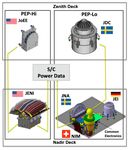The Particle Environment Package on board JUICE: What Can We Learn about Callisto's Atmosphere and Space Environment? - Meeting Organizer
←
→
Page content transcription
If your browser does not render page correctly, please read the page content below
The Particle Environment Package on board JUICE:
What Can We Learn about Callisto’s Atmosphere and
Space Environment?
University of Bern,
A. Galli, A.
Switzerland; Center for
Vorburger, S.R. Space Science, NYU Abu
Carberry Mogan Dhabi, UAE; Max Planck
E. Roussos, Institute for Solar System
G. Stenberg-Wieser, Research, Germany;
P. Wurz, M. Föhn, Swedish Institute of Space
N. Krupp, S. Physics, Sweden; Johns
Barabash, Y. Hopkins University, USA;
University College London,
Futaana, P.C.
UK; University of Virginia,
Brandt,
USA; NASA Goddard
P. Kollmann, D. Space Flight Center, USA;
Haggerty, School of Earth &
G. Jones, R.E. Atmospheric Sciences,
Johnson, O.J. Georgia Institute of
Tucker, S. Simon, Technology, USA; Space
T. Tippens, L. Liuzzo Sciences Laboratory,
University of California,
USA
23rd September, 2021 Presentation EPSC2021-169 EPSC 2021The Jupiter Icy Moons Explorer (JUICE) will fly by
Callisto 21 times before entering into Ganymede’s orbit
Sn+ On+
H+
e-
Callisto
Magnetosphere of Jupiter with plasma from Io and other sources (image source: wikipedia)
EPSC 2021 Galli et al. 2JUICE trajectory implications for Callisto observations
(Baseline: CREMA 5.0 for JUICE launch in September 2021, Reference:
www.cosmos.esa.int/web/spice/spice-for-juice)
21 Callisto flybys: 12x polar, 6x upstream, 3x downstream
polar upstream downstream
Y: Jupiter
direction
plasma
wake
X: Plasma
co-rotation
JUICE ground tracks on
Callisto’s surface:
12 flybys at h < 500 km!
Polar and equatorial
regions covered
Check it out yourself at
https://juicept.esac.esa.int
ESA report “Trajectory Analysis Report - CREMA 4.2B/150L0A”
EPSC 2021 Galli et al. 3PEP: Combine in-situ neutrals, ions, electrons, and remote Energetic Neutral Atoms into one big picture Particle Environment Package (PEP) = six different instruments: ● NIM: Neutral gas and ion mass spectrometer (thermal energies) ● JDC: Ion spectrometer and mass analyzer (electron capabilities) ● JEI: Electron spectrometer (ion capabilities) ● JoEE: Energetic electrons spectrometer ● JNA: Low energy ENA imager ● JENI: Energetic ion spectrometer and ENA imager (electron capabilities) EPSC 2021 Galli et al. 4
Planning PEP Operations during Callisto flybys:
Neutrals, plasma, and Energetic Neutral Atoms
Predicted profiles of the major
atmospheric neutral species
(Carberry Mogan et al., 2021) for
various solar zenith angles;
solid lines: 0°, dashed lines: 90°,
dotted lines: 180°; JUICE closest
approach at 200 km altitude;
detection threshold would be 1 cm-3
Magnetic field structure (left) and predicted ENA emissions from Callisto
(right panel), caused by energetic ions charge-exchanging with neutrals
Jupiter-facing
EPSC 2021 Galli et al. 5Summary
> JUICE trajectory 5.0: 21 flybys in total, 12 flybys at altitude < 500 km, dayside
and nightside. Good for Callisto surface coverage; for plasma science and
atmospheric loss studies more downstream flybys would be preferable.
> Neutral densities: Low flyby altitude is crucial to detect heavy species, in
particular for nightside flybys.
> PEP: Try to get parallel electron, ion, and neutrals data on the way to closest
approach, after closest approach no useful neutrals measurements possible.
> PEP: ~10s shortest measurement interval except for electron data (~1s).
> PEP: Background rates due to radiation levels in Jovian magnetosphere at
Callisto much lower than near Europa or Ganymede.
> Implications for models and theory:
→ Ongoing improvement of atmosphere models (1d, 2d, 3d, collisions,…).
→ Combine plasma and atmosphere models of Callisto.
→ First model predictions of Energetic Neutral Atoms images from Callisto
done, more details will be published in separate paper.
> PEP input for models: more accurate and localized measurements of plasma,
neutral atmosphere (spatial distribution), and surface composition to better
constrain models of the Callisto atmosphere and plasma environment.
> Questions and comments? Write to andre.galli@unibe.ch.
Publication of this study is in preparation.
EPSC 2021 Galli et al. 6You can also read



























































